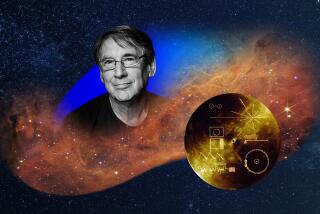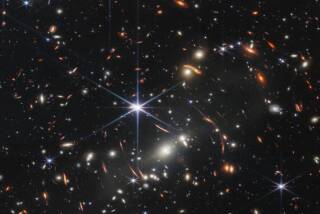An Eye-Opening Look at Astronomy and Reality
- Share via
Sometimes, astronomy is unreal. Really.
Those spectacular pictures from the Hubble Space Telescope of exploding stars and nebulous gas clouds and stars emerging from dusty cocoons are all--to one extent or another--computer-enhanced. The rose-red Martian landscapes and candy-colored rings around Saturn don’t reflect what you’d see in a telescope from your backyard. The images are processed, spiffed up, airbrushed and painted like so many Hollywood stars.
People sometimes look through ordinary backyard telescopes and feel betrayed. They don’t see enormous green and purple glowing clouds of gas. Saturn looks mostly black and white. This moment of truth is like Dorothy’s discovery that the great and powerful wizard of Oz is really just a guy behind a curtain with a few special effects.
But is it deception, really?
Curiously, when Galileo first looked through his crude telescope and saw mountains on the moon and moons around Jupiter, people thought he was seeing an optical illusion. His telescope, they said, was creating distortions. Anything you couldn’t see with your naked eye, in other words, wasn’t really real.
Of course, Galileo’s detractors had hidden agendas. In a perfect world that was the center of a perfect universe, no one wanted to see imperfections on supposedly perfect heavenly bodies or, heaven forbid, satellites orbiting worlds other than Earth.
Today, we don’t worry about the reality of the things we see through lenses. In fact, many of us walk around with lenses floating on our eyeballs or perched on our noses, the better to see the world.
Moreover, we know that the images we see in our mind’s eye are exhaustively processed by our brains. The brain rights the upside-down images on our retinas, fills in blind spots, erases extraneous “noise” such as blood vessels and floating bits of fluff from our field of vision. The brain adjusts for motion, “corrects” colors and puts things in their proper perspective.
In their own way, that’s just what the Hubble scientists do. According to Astronomy magazine associate editor Robert Neaye, who recently ran a retrospective of Hubble treasures in his publication, the astronomers have to clean up “noise” in the images, such as cosmic ray tracks, and clear up distortions. “The astronomers have to do some processing to make them look spiffy,” he said. “You have to do a little massaging to make them sing.”
What’s more, the Hubble images come down in black and white. They’re snapped through different filters sensitive to different colors. The astronomers put them back together. That’s also more or less the way the human eye works--three different kinds of color-sensitive cells “snap” images, which the brain reassembles.
So it would be difficult to argue that the Hubble images are somehow dishonest. After all, there’s no such thing as an unprocessed, unfiltered image. For that matter, there’s no such thing as an unprocessed sense perception, be it sound, touch, taste or smell.
Color and smell arrive at the brain as electrical signals, which the brain “massages” into sensations such as “blue” or “freshly cut grass.” As Galileo recognized, qualities such as color and smell “can no more be ascribed to the external objects than can the tickling or pain caused sometimes by touching such objects.”
Whether or not we distort these perceptions when we “enhance” them with hearing aids or other similar devices is a moot point. Everything we sense from the outside world is created in our minds from heavily processed and filtered information.
Some objects in space appear downright tacky. They really look unreal. While we think of the hot sun as the standard of “natural” light, cooler glowing gas clouds emit light in the same way as neon signs.
“They’re nature’s equivalent of going down a Las Vegas strip,” said Hubble Space Telescope spokesman Ray Villard. “It gives us some very gaudy images.” While the Hubble tries to keep its processed images as true to life as possible, the scientists haven’t decided exactly what to call this “massaged” version of reality. “We have debated it here,” said Villard. “If we try to say [the images are] true color, or natural color, that can be misleading. But if you say false color, people think you’re trying to deceive them.”
The truth of the matter is hard to explain: Yes, the Hubble images are processed, filtered, reassembled, artificially colored and generally jazzed up. But they are no more jazzed up than the images we see with our own two eyes.






